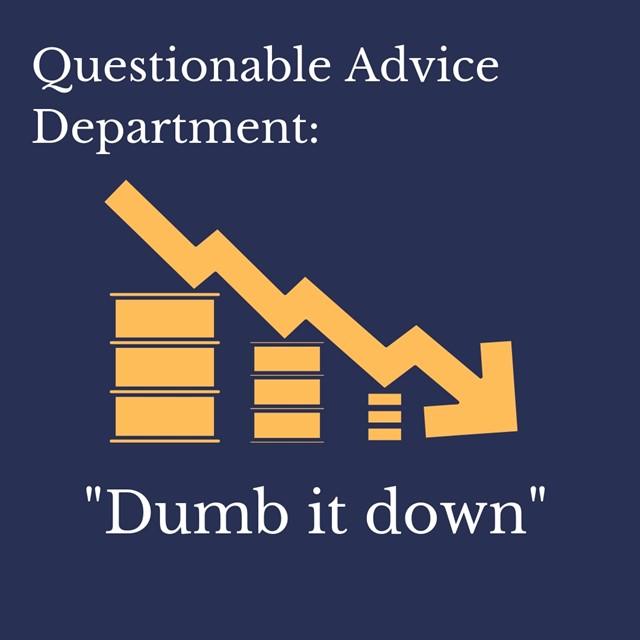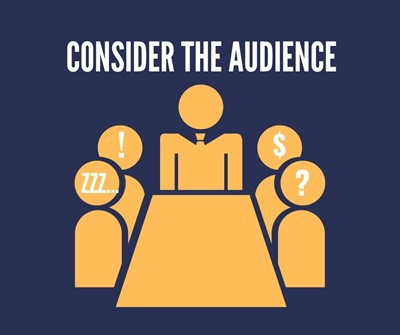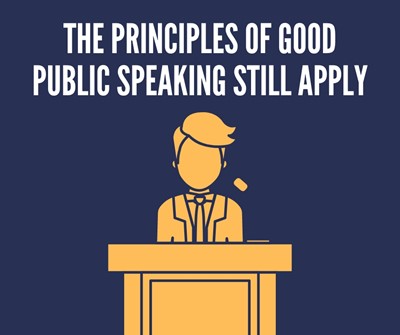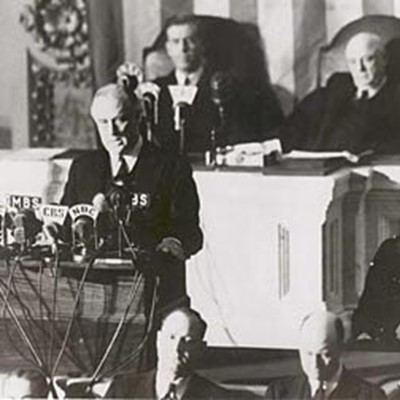
"The term 'dumbing down' originated in 1933, as movie-business slang used by screenplay writers, meaning: '[to] revise so as to appeal to those of little education or intelligence.'"
– From the Wikipedia entry for "dumbing down"
We’ve certainly untangled our share of complex scientific and financial presentations.
And nothing stirs our ire quite like someone saying, "Yeah , I guess we have to dumb it down."
There is nothing dumb—or easy—about making complicated information accessible (and interesting) for an audience.
We’ve found that even the smartest, most technically-adept audiences benefit from a presentation that strives for clarity and concision.
How do you make a complex message easier to understand without performing the dumb-down we loathe?

1. Consider your audience
This should be your part of your process for any presentation—and when the material is complex, understanding the audience is how you move toward making it clear.
Some ways you can apply what you know about your audience include:
- Word choice—If technical terms aren’t readily understood, either don’t use them, define them, or use them in a context that makes their meaning clear.
- Visuals—If a complex chart or graph will be difficult for the audience, present visual information in a different format. Saying “I’m sorry this is an eye chart” doesn’t solve the problem. Consider how to put complex data in people’s hands or on their screens so that they don’t have to squint at your PowerPoint slides.
- Stories, analogies, and examples—Well chosen, these can help you and everyone else speed their understanding of what you mean. Even in groups of scientists working on similar projects, not all interpret information in the same way. Your story won’t be frivolous if it illustrates the problem you’re working to solve or the way the data applies.
- Level of detail—We find that executives want to know where you’re going before you launch into detail while engineers and scientists have more tolerance for the particulars and the process. Don’t leave out critical information but weigh whether the level of detail you present fits the audience.

2. Define your goal
- Are you convincing an investor you’ve done the research and have a viable product?
- Have you discovered something that will be exciting or concerning?
- Is a crisis looming?
- Or are you weighing different options and looking for new perspectives from the room?
Your goal plus your audience should be an equation that helps you determine how to structure your presentation. Make sure you’re clear in your own mind about your primary goal—and that the audience can walk away able to state in a sentence your main message and the purpose of your presentation.

3. Present using short sentences, simple words, purposeful organization, and visible enthusiasm
- An idea broken into short sentences or phrases is often easier to follow.
- Using multi-syllable words and jargon doesn't help the audience—and doesn’t make you look as smart as you might think.
- Even serious people need to show a spark of intensity, passion, or concern when presenting.
These techniques are not about pandering to an audience—but about showing them some respect.
Taking an audience-friendly approach
In the spirit of using an example, here’s one way you might approach individual slides in a dense PowerPoint presentation.
- Lead off the slide by stating the main idea—whether you phrase that as an assertion or question.
- Then present information that fleshes out that main message. If possible, consider using the Rule of Three to structure the information (though not all data will lend itself to three points or categories).
- Conclude by restating the main idea and link it to the next slide as you transition.
Many detail-oriented speakers tend to deliver all the data, building to a summary that’s the main idea. By using your main message to start each slide, you help the audience by giving them a framework on which to hang the details that follow.
If it's good enough for Einstein...
Of course, you don’t want to sound dumb or look dumb. But too often we see speakers who:
- Don’t want to put in the effort to make a complex message easier to understand.
- Worry they’ll be ridiculed for doing things differently "because everyone presents that way" in their industry or profession
- Want to be sure they sound "smart" and "credible"—and believe using big word and institutional language is how they pull that off.
Instead, we hope you’ll consider having smart ideas and expressing them as clearly as possible, using simple words and sentences. And not describe that process as "dumbing it down."
Albert Einstein said, "If you can’t explain it simply, you don’t understand it well enough."
And if you’re looking for a scientist’s insights on how to make presentations more accessible, you might like this website.






